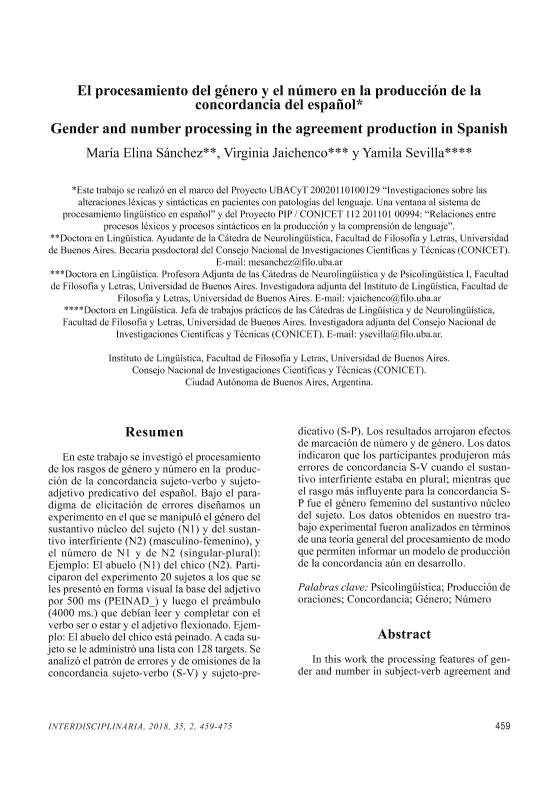Artículo
En este trabajo se investigó el procesamiento de los rasgos de género y número en la producción de la concordancia sujeto-verbo y sujeto-adjetivo predicativo del español. Bajo el paradigma de elicitación de errores diseñamos un experimento en el que se manipuló el Género del sustantivo núcleo del sujeto (N1) y del sustantivo interfiriente (N2) (Masculino-Femenino), y el Número de N1 y de N2 (Singular-Plural): Ejemplo: El abuelo (N1) del chico (N2). Participaron del experimento 20 sujetos a los que se les presentó en forma visual la base del adjetivo por 500 ms. (PEINAD_) y luego el preámbulo (4000 ms.) que debían leer y completar con el verbo ser o estar y el adjetivo flexionado: Ejemplo: El abuelo del chico está peinado. A cada sujeto se le administró una lista con 128 targets. Se analizó el patrón de errores y de omisiones de la concordancia sujeto-verbo (S-V) y sujeto-predicativo (S-P). Los resultados arrojaron efectos de marcación de número y de género. Los datos indicaron que los participantes produjeron más errores de concordancia S-V cuando el sustantivo interfiriente estaba en plural; mientras que el rasgo más influyente para la concordancia S-P fue el género femenino del sustantivo núcleo del sujeto. Los datos obtenidos en nuestro trabajo experimental fueron analizados en términos de una teoría general del procesamiento de modo que permiten informar un modelo de producción de la concordancia aún en desarrollo. In this work the processing features of gender and number in subject-verb agreement and subject-predicate adjective in the sentence production in Spanish was investigated. As a general objective, in this work we set out to investigate the processing of the features that come into play in both subject-verb and subject-adjective predicative agreement in our language. Specifically, an attempt will be made to answer if the features of gender and number are processed in the same way, if the feature have a default value and if the values present differences, that is, if the singular differs from the plural, and the masculine from the feminine. This will allow us to establish if any of these values is more error-sensitive. In addition, we seek to identify the role of the marking concept. Under the paradigm of error elicitation we designed an experiment in which the Gender of the head noun (N1) and local noun (N2) (Masculine-Feminine), and the Number of N1 and N2 (Singular-Plural) was manipulated: Example: El abuelo (N1) del niño (N2). 20 subjects participated in the experiment which were presented in visual form the basis of the adjective for 500 ms. (PEINAD_) and then the preamble (4000 ms.) The participants read and completed with the verb “to be” and inflected adjective: Example: El abuelo del niño está peinado. Each participant was given a list of 128 targets. The pattern of errors and omissions of subject-verb agreement (S-V) and subject-predicate (S-P) was analyzed. The results showed main effects of number and gender. The data indicated that the participants produced more attraction errors of S-V when the local noun was in plural; while the most influential feature for S-P agreement was the feminine gender of the head noun of the subject. In summary, in relation to the agreement between the subject and the verb, and specifically, for the number feature, classical asymmetry was found, with greater interference when the head noun appeared in singular and the local noun in plural. The surprising fact, which could come to light given the characteristics of the design of the experiment, is that the attraction occurred more strongly when the gender of both nouns matched. With regard to agreement of subject- adjective predicate, and with respect to the gender of the nouns and the adjective, a main effect of the gender of the head noun was found, with more errors when the N1 appeared in feminine. We also found an interaction between the gender of N1 and the gender of N2, with more errors when the N1 appeared in feminine and N2 in masculine, and at the same time when the number of both coincided. The data suggest that it seems that the most influential feature to make the agreement between the subject and the predicate adjective is the gender of head noun, with a higher probability of interference when it appears in the feminine gender. In sum, our experimental research gathered evidence that allows us to progress in the characterization of how and when the processing of agreement and interference occurring in situations forced by experimental conditions as in natural speech. In particular, we analyze the characteristics of the gender and number features and the role of the marking concept. The data obtained in our experimental work were analyzed in terms of a general theory of processing so as to inform a production model of the still developing agreement.
El procesamiento del género y el número en la producción de la concordancia del español
Fecha de publicación:
08/2018
Editorial:
Consejo Superior de Investigaciones Científicas. Centro Interamericano de Investigaciones Psicológicas y Ciencias Afines
Revista:
Interdisciplinaria
ISSN:
1668-7027
Idioma:
Español
Tipo de recurso:
Artículo publicado
Clasificación temática:
Resumen
Palabras clave:
PSICOLINGÜÍSTICA
,
PRODUCCIÓN DE ORACIONES
,
CONCORDANCIA
,
GÉNERO Y NÚMERO
Archivos asociados
Licencia
Identificadores
Colecciones
Articulos(SEDE CENTRAL)
Articulos de SEDE CENTRAL
Articulos de SEDE CENTRAL
Citación
Sánchez, María Elina; Jaichenco, Virginia Irene; Sevilla, Yamila Alejandra; El procesamiento del género y el número en la producción de la concordancia del español; Consejo Superior de Investigaciones Científicas. Centro Interamericano de Investigaciones Psicológicas y Ciencias Afines; Interdisciplinaria; 35; 2; 8-2018; 459-475
Compartir




